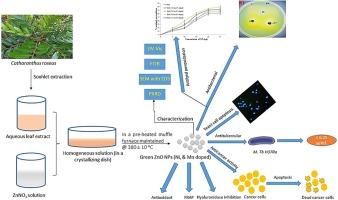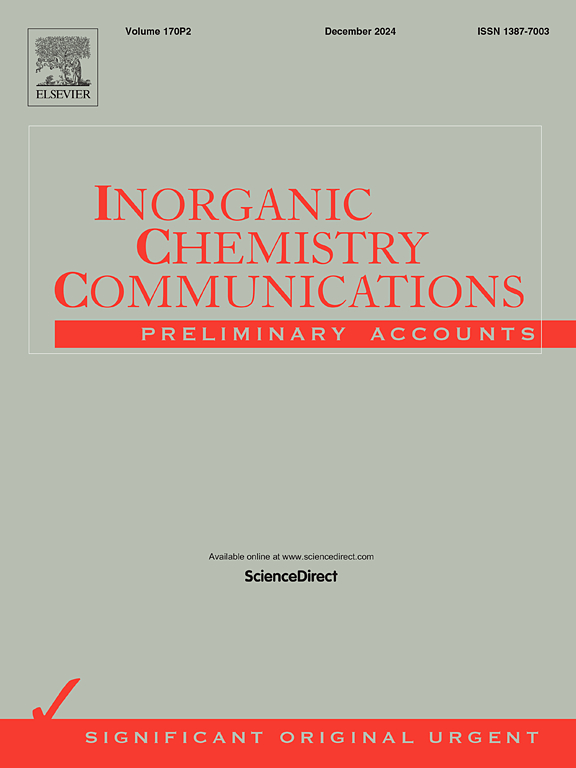Sustainable bio-fabrication of Ni/Mn co-doped ZnO nanoparticles using Simarouba glauca leaf extract: Evaluation of non-cytotoxic, anti-carcinogenic, anti-tubercular, anti-bacterial properties, anti-oxidant and hyaluronidase inhibition activities
IF 4.4
3区 化学
Q1 CHEMISTRY, INORGANIC & NUCLEAR
引用次数: 0
Abstract
Metal oxide nanomaterials, notably ZnO NPs, have emerged as pivotal components in various industries due to their exceptional properties. This study focuses on enhancing the bioactive properties of ZnO NPs by co-doping them with Ni and Mn, employing a cost-effective and eco-friendly synthesis method utilizing S. glauca leaf extract as a bio-reductant. Characterization techniques including PXRD, SEM, EDAX, FTIR, and UV–Visible were utilized to analyse the synthesized NPs. The research evaluated the anti-carcinogenic anti-tubercular and anti-bacterial activities. Cytotoxicity of the NPs was examined towards general mammalian cells and yeast cells. Antioxidant activity was determined by Free radical scavenging, Power to reduce ferric ions and inhibition of lipid peroxidation. Also examined the potential of NPs to inhibit the Hyaluronidase enzyme activity, that breaks down Hyaluronic acid and helps in the prognosis of tumour metastasis. Results revealed, significant impacts on these biological processes, highlighting the relevance of our findings for cytotoxicity assessment, therapeutic applications, and biomedical advancements. Results indicated promising potential for Ni and Mn-doped ZnO NPs across various biomedical applications, demonstrating enhanced cytotoxicity against cancer cells, antimicrobial efficacy, antioxidant properties, and enzyme-inhibitory effects. The study concludes that the doped NPs offer versatile functionalities, paving the way for further exploration and development in biomedical and clinical applications, with potential implications for improving healthcare and patient outcomes.

利用青叶提取物可持续生物制备Ni/Mn共掺杂ZnO纳米颗粒:无细胞毒性、抗癌、抗结核、抗菌、抗氧化和透明质酸酶抑制活性的评价
金属氧化物纳米材料,特别是氧化锌纳米粒子,由于其特殊的性能,已经成为各种工业的关键部件。本研究主要研究了以青叶提取物为生物还原剂,通过与Ni和Mn共掺杂来增强ZnO纳米粒子的生物活性。利用PXRD、SEM、EDAX、FTIR、UV-Visible等表征技术对合成的NPs进行了分析。研究评价了其抗癌、抗结核和抗菌活性。研究了NPs对一般哺乳动物细胞和酵母细胞的细胞毒性。通过自由基清除能力、还原铁离子能力和抑制脂质过氧化作用测定其抗氧化活性。同时研究了NPs抑制透明质酸酶活性的潜力,这种酶能分解透明质酸,并有助于肿瘤转移的预后。结果显示,对这些生物过程有重大影响,突出了我们的发现与细胞毒性评估、治疗应用和生物医学进步的相关性。结果表明,Ni和mn掺杂ZnO NPs在各种生物医学应用中具有良好的潜力,显示出增强的细胞毒性,抗微生物功效,抗氧化性能和酶抑制作用。该研究的结论是,掺杂的NPs具有多种功能,为进一步探索和开发生物医学和临床应用铺平了道路,对改善医疗保健和患者治疗效果有潜在的影响。
本文章由计算机程序翻译,如有差异,请以英文原文为准。
求助全文
约1分钟内获得全文
求助全文
来源期刊

Inorganic Chemistry Communications
化学-无机化学与核化学
CiteScore
5.50
自引率
7.90%
发文量
1013
审稿时长
53 days
期刊介绍:
Launched in January 1998, Inorganic Chemistry Communications is an international journal dedicated to the rapid publication of short communications in the major areas of inorganic, organometallic and supramolecular chemistry. Topics include synthetic and reaction chemistry, kinetics and mechanisms of reactions, bioinorganic chemistry, photochemistry and the use of metal and organometallic compounds in stoichiometric and catalytic synthesis or organic compounds.
 求助内容:
求助内容: 应助结果提醒方式:
应助结果提醒方式:


